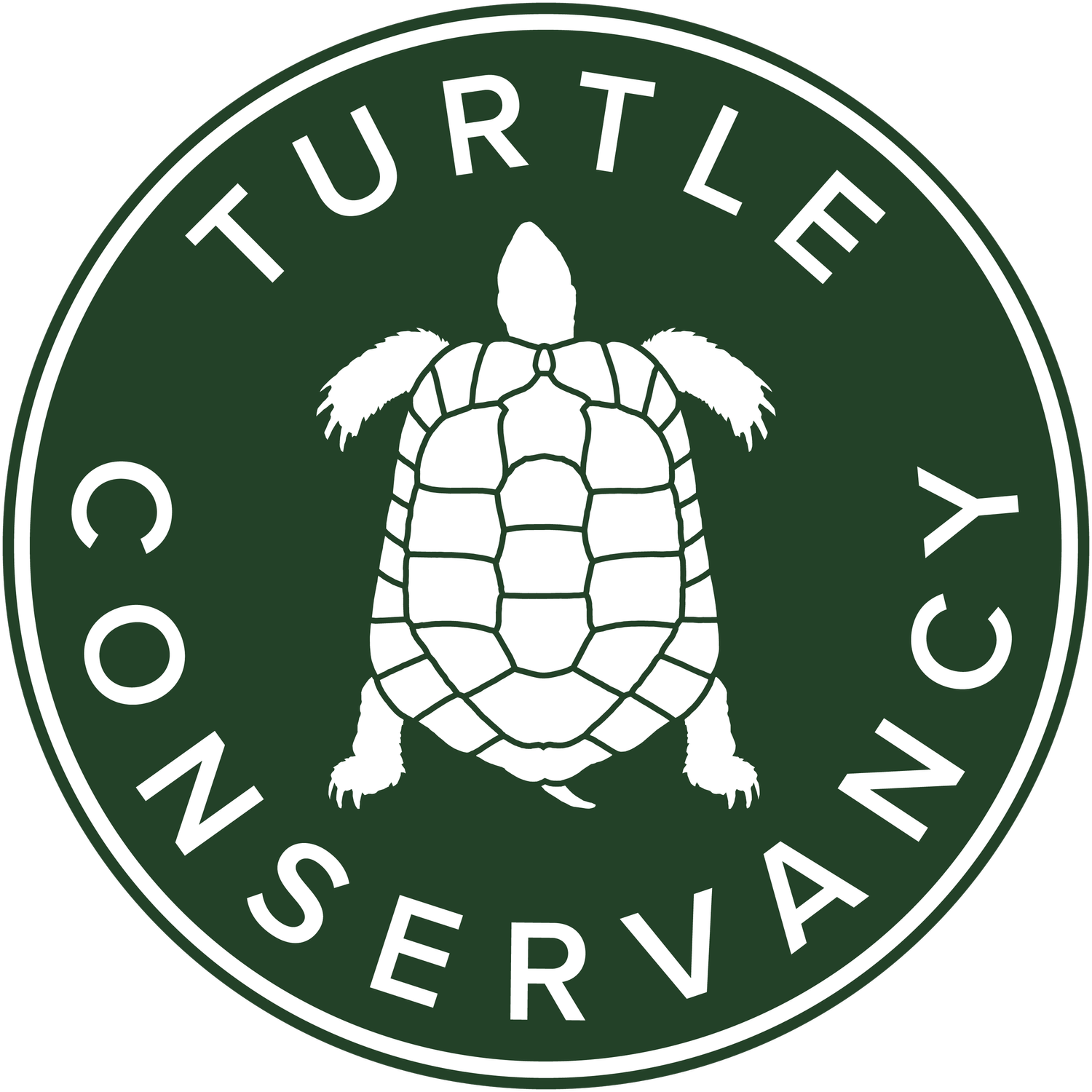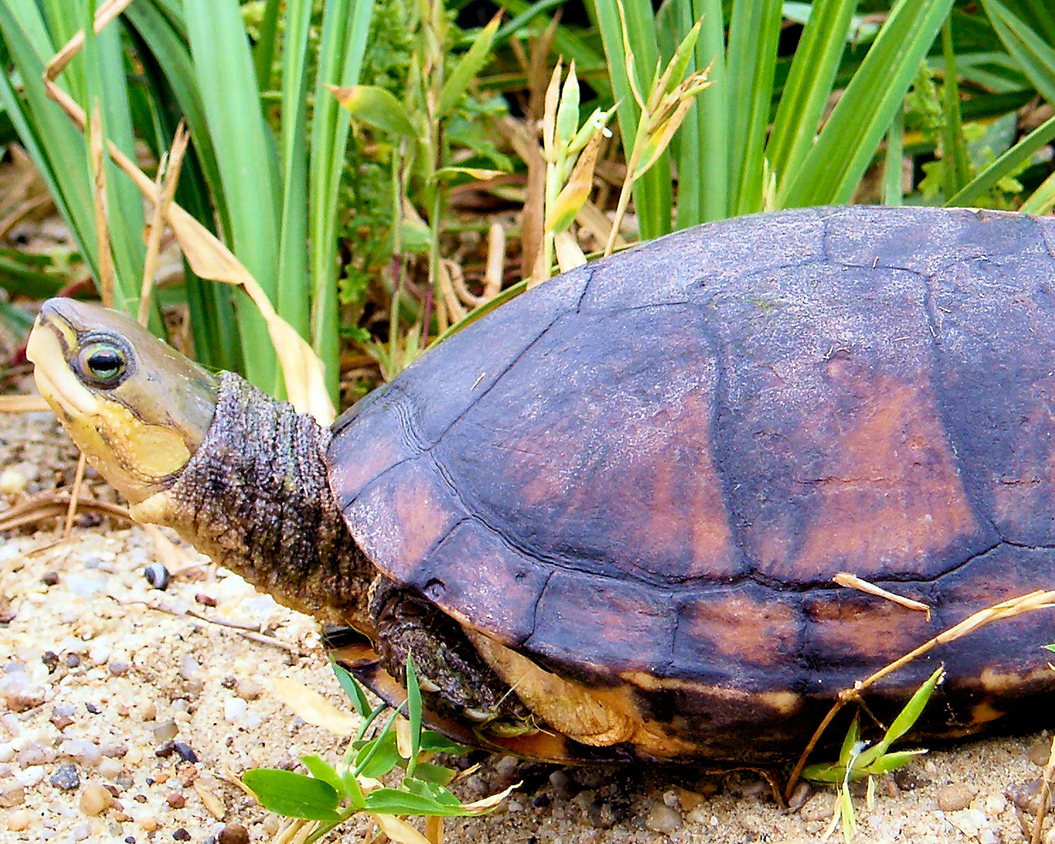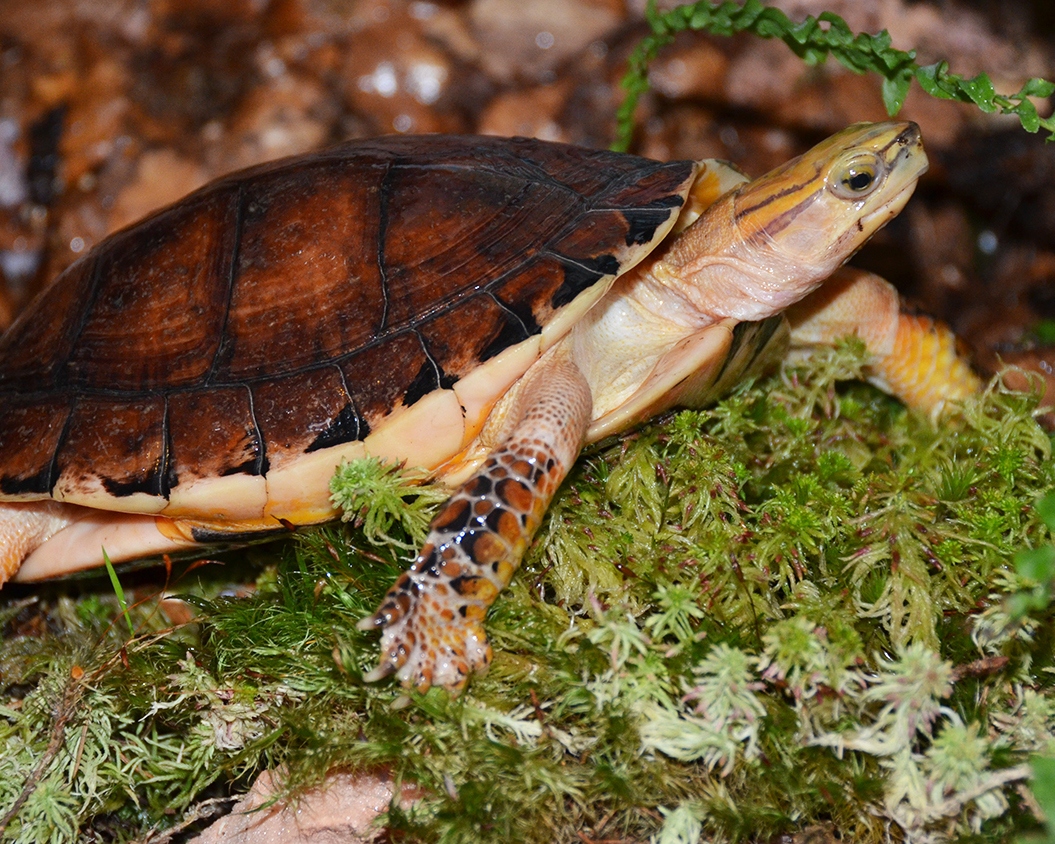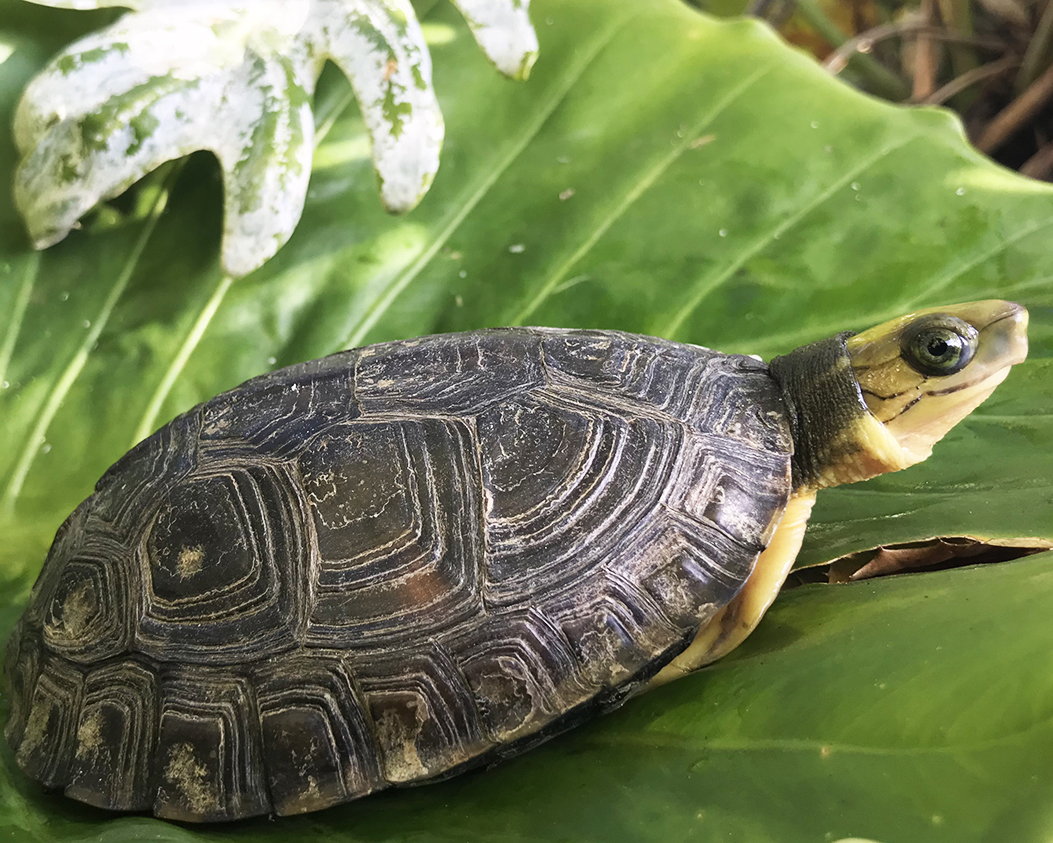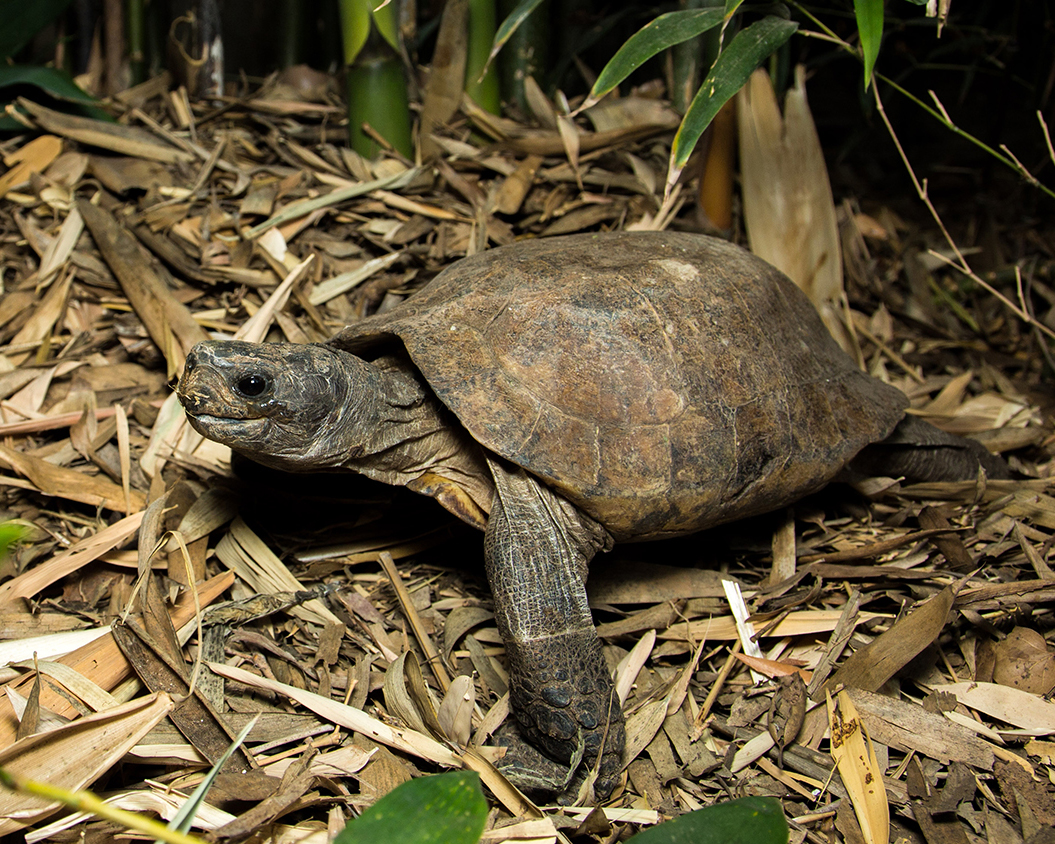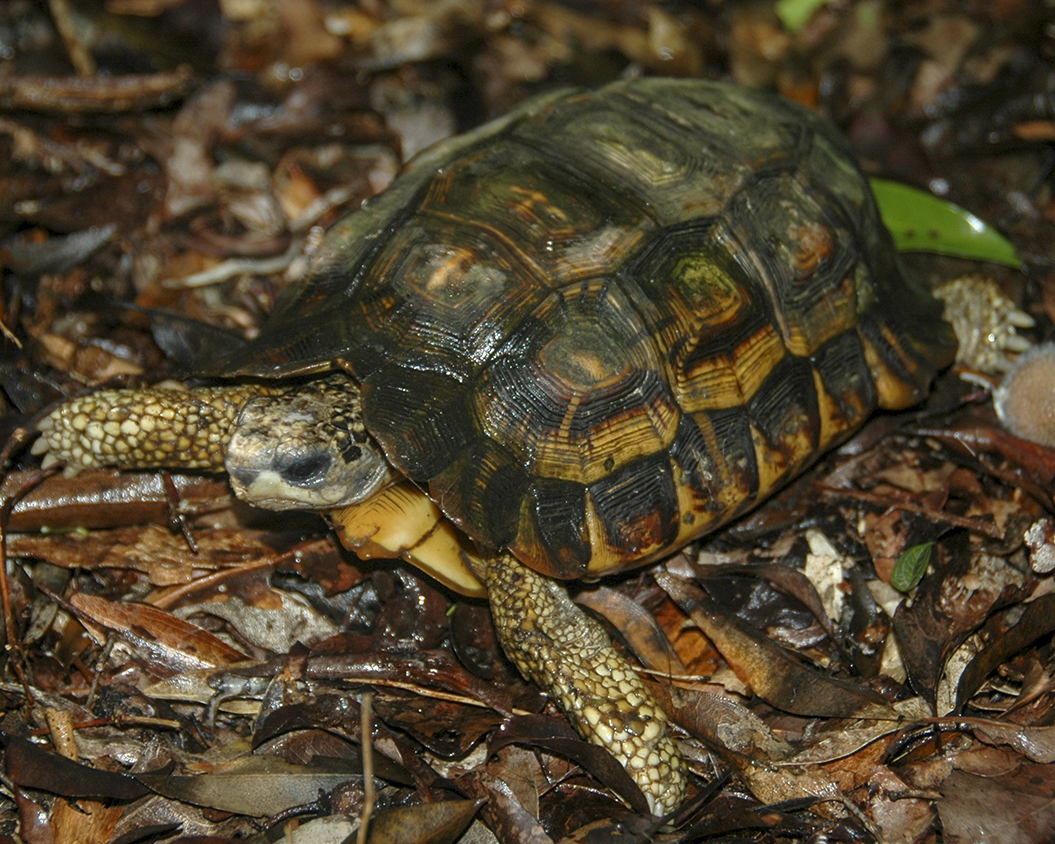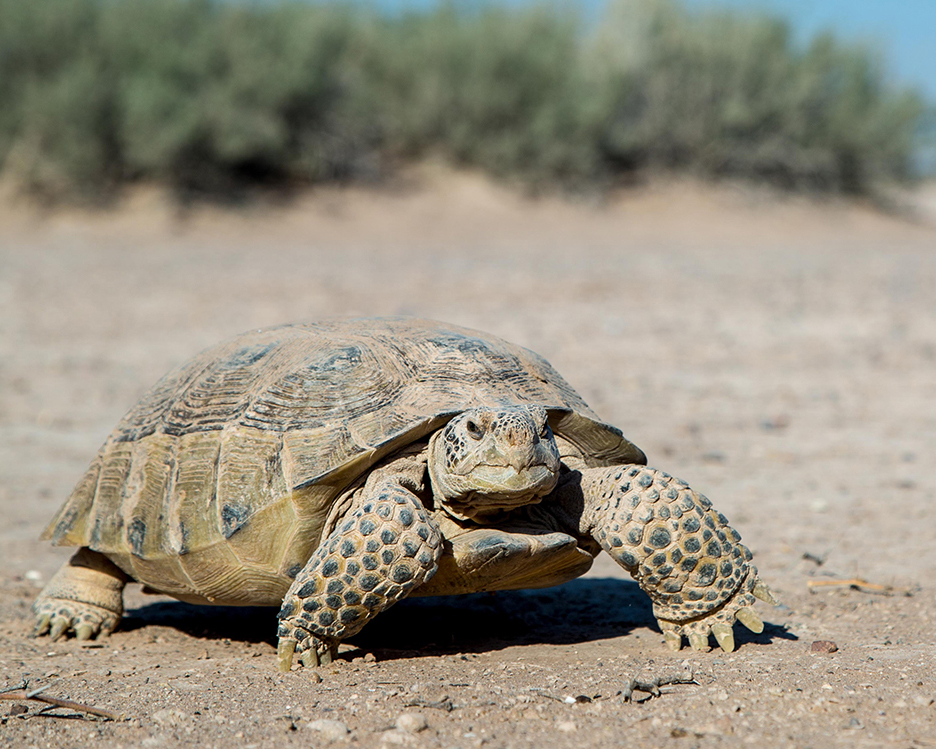Turtles in Trouble
With half of all turtle and tortoise species threatened with extinction, turtles are one of the world’s most endangered vertebrate groups. A new report from the Turtle Conservation Coalition—a collaborative partnership of leading turtle conservation organizations—highlights the world’s 25+ most imperiled tortoise and freshwater turtle species, and the conservation opportunities to prevent their extinction.
Yangtze Giant Softshell Turtle
One of the largest freshwater turtles in the world, reaching 120 kg, Rafetus swinhoei is known from the Red River in China and Vietnam and from China’s lower Yangtze River floodplain. Capture for consumption, river damming, wetland destruction, and water pollution reduced the global population to only three individuals, one in a reservoir west of Hanoi and a captive pair in China residing since 2008 in Suzhou Zoo...
Ploughshare Tortoise
The beautiful Ploughshare Tortoise may be the most critically endangered tortoise in the world. Males have an elongated plough-shaped gular projection emerging from the plastron used in breeding jousts aimed at flipping over their opponents. The species is restricted to a single protected area, Baly Bay National Park, in northwestern Madagascar, created in 1998 with the tortoise as the primary conservation target...
Yunnan Box Turtle
Cuora yunnanensis was described in 1906 from Yunnan Province in southern China. After its initial description, it all but vanished from scientific view for the next nearly 100 years. This predominantly brown colored turtle reaches carapace lengths of 12–19.5 cm, males being smaller, flatter and with a larger and thicker tail...
Northern River Terrapin
The Northern River Terrapin, Batagur baska, has declined largely due to over collection of both adults and eggs for human consumption and is now rare in the rivers and deltas of India, Bangladesh, and Myanmar. Habitat loss and degradation due to sand mining, dam construction, and pollution have also contributed to this species’ decline...
Myanmar Roofed Turtle
Once on the brink of extinction with fewer than a dozen individuals remaining, the Myanmar Roofed Turtle, Batagur trivittata, now numbers close to a thousand captive individuals. The majority of these are in four assurance colonies: three in Myanmar and one in Singapore...
Zhou’s Box Turtle
This Cuora species only became known to science when it was described in 1990 based on a handful of specimens from two markets in southern China’s Guangxi Province bordering with Vietnam. A year later, the species received a synonym, Cuora pallidicephala, by American scientists, having received specimens of this species in 1989 from a Hong Kong turtle trader...
McCord’s Box Turtle
Cuora mccordi is a yellow-headed and chestnut-brown-shelled Asian box turtle. It reaches carapace lengths of 14–23 cm, and is sexually dimorphic, with males usually smaller than females, and possessing a thicker, longer tail and a more elongated and flatter carapace...
Geometric Tortoise
Psammobates geometricus is a small (carapace length 10–15 cm) non-burrowing tortoise closely associated with a unique native shrubland (Alluvium Fynbos) in the Mediterranean-climate zone of the Western Cape, South Africa. It is Critically Endangered, with a declining wild population estimated at fewer than 1,000 individuals. More than 90% of the species’ low elevation (70–600 m) habitat has been lost to agricultural expansion and urbanization over the past two centuries...
Golden-headed Box turtle
Cuora aurocapitata is a highly aquatic Asian box turtle, reaching a carapace length of 10–19.5 cm. It is sexually dimorphic; males are smaller than females and have a flatter carapace and longer, thicker tail. In 2017, the species was split into two subspecies: the nominate subspecies from southern Anhui and the new subspecies Cuora aurocapitata dabieshani from central Anhui...
Dahl’s Toad-headed Turtle
This medium sized (to 30 cm) semi-aquatic turtle is a rare and endemic species to northern Colombia, and the only member of the Chelidae family occurring northwest of the Andes. For several decades after its description, this species was only known to occur at its type locality, and thus it was listed as Critically Endangered and included in the list of the world’s 25 most threatened turtles in 2003...
Nubian Flapshell turtle
The Nubian Flapshell Turtle is a large softshell species, with a carapace length up to 70 cm. It is the largest member of the subfamily Cyclanorbinae. Cyclanorbis elegans can be distinguished from its congener C. senegalensis by the presence of two, or less commonly, four plastral callosities in adults. The smaller C. senegalensis has up to nine callosities...
Three-Striped Box Turtle
Cuora trifasciata reaches 15–26 cm carapace length; males have a thicker and longer tail. The carapace is chestnut brown with three longitudinal stripes, giving the species its scientific name. The plastron is black and the head is yellow with black lines and a brown blotch behind the eye...
Burmese Star Tortoise
The Burmese Star Tortoise (Geochelone platynota) is one of the rarest tortoises in the world. It has been considered functionally extinct in the wild for more than a decade, and only in recent years have some captive bred animals been released in the wild. Little is known about this species in the wild...
RotI Island Snake-necked Turtle
Chelodina mccordi is a medium-sized sidenecked turtle (maximum carapace length 24 cm) found on the small Indonesian island of Roti (Rote) as well as in Timor-Leste. Three subspecies are currently recognized: C. m. mccordi (Western Roti Snake-necked Turtle), C. m. roteensis (Eastern Roti Snake-necked Turtle), and C. m. timorensis (Timor Snake-necked Turtle). The Timor-Leste taxon may be a separate species...
Southeast Asian Narrow-Headed Softshell Turtle
With a recorded maximum size of well over 120 cm (4 feet) carapace length and 254 kg weight, Chitra chitra is the largest known freshwater turtle. The Southeast Asian Narrow-headed Softshell turtle is an ambush fish-eater, hunting by sight and inhabiting clear-water rivers in Thailand, West Malaysia, Java, and possibly Sumatra...
Bellinger River Snapping Turtle
Myuchelys georgesi is a distinctive lineage of chelid turtle that is restricted to a small coastal drainage, the Bellinger River, in New South Wales, Australia. The species is threatened as a relictual lineage restricted to an exceptionally small range (35 km linear range). It is also threatened by substantial changes in land use and clearing in the Bellinger catchment...
Vietnamese Pond Turtle
Mauremys annamensis is a medium-sized turtle (females to 29 cm, males to 23 cm) endemic to seven provinces of central Vietnam, where it appears to be largely restricted to lowland wetland areas below 200 m elevation. Geographic barriers further limit the species’ range...
Central American River Turtle
The Central American River Turtle is the last remaining representative of a turtle family that dates back 65 million years. The species reaches 65 cm and can weigh up to 22 kg. Males can be distinguished by their golden-yellow heads. Dermatemys mawii is entirely aquatic, inhabiting rivers, lagoons, and other large wetlands in southern Mexico, Guatemala, and Belize...
Madagascar Big-headed Turtle
This turtle reaches 50 cm carapace length and 17 kg and is the only living Old World representative of the family Podocnemididae. Fully-grown adults have a large head with a strong temporal helmet, or casque. They are omnivorous, feeding on molluscs, fish, and amphibians, and seasonally also on fruits and seeds from broadleaf trees and palms, as well as on aquatic vegetation as water levels rise and fall...
Southern River Terrapin
The Southern River Terrapin was until recently considered to be part of the wide-ranging species Batagur baska (from India to Indonesia). Genetic analysis determined that the species should be split into two; the Northern River Terrapin, B. baska, and the Southern River Terrapin, B. affinis, which includes the Western Malay River Terrapin, B. a. affinis, and the Eastern Malay River Terrapin, B. a. edwardmolli. This species has been heavily exploited for its flesh and eggs and only small isolated populations remain...
Red-Crowned Roof Turtle
The Red-crowned Roof Turtle (to 60 cm) has been decimated across its former range due to high levels of hunting and habitat degradation. Once found throughout the entire Gangetic River system, the last potentially long-term viable population is now found only within the National Chambal River Sanctuary. Based on over a decade of nest surveys, it is estimated that less than 500 adult females remain within the 400 km long sanctuary...
Sulawesi Forest Turtle
This medium-sized (to 28 cm) semi-aquatic turtle is endemic to the Indonesian island of Sulawesi. Frank Yuwono, after whom the species is named, obtained the first specimen known to science from a market in Gorontalo; the species was formally described to science only in 1995. Males are much larger than females and distinguished by their whitish heads. No detailed field studies have been carried out, but the species’ preferred habitat appears to be cool shallow streams that flow from the mountains...
Western Swamp Turtle
Due to massive habitat loss and despite the creation in 1962 of two small nature reserves encompassing all known habitat fragments, the wild population of Pseudemydura umbrina, a slowly reproducing ephemeral clay swamp specialist, dropped from over 200 in the 1960s to fewer than 30 individuals by 1987. Together with 17 captive individuals, which did not breed, the world population was below 50...
Hoge’s Side-Necked Turtle
Hoge’s Side-necked Turtle (Mesoclemmys hogei) is a Critically Endangered freshwater turtle with a restricted geographic range in the Brazilian southeastern Atlantic Forest, notably in the Carangola River of Minas Gerais and Paraíba do Sul River, Rio de Janeiro. The Brazilian official Red List notes it as the most endangered turtle of Brazil...
PALAWAN FOREST TURTLE
The Palawan Forest Turtle was formerly known only from museum specimens allegedly collected on the island of Leyte in the 1920s. For almost 70 years, biologists were unable to locate additional specimens. Finally, in 1987 a specimen was purchased in a food market in northern Palawan. It is now known to be endemic to the Palawan island group, and does not occur on Leyte...
Magdalena River Turtle
This large herbivorous river turtle (to 50 cm) is the only member of the Family Podocnemididae to occur northwest of the Andes Mountains. Much of the land bordering the riverine habitat that this species occupies has been converted to pastures or plantations. The draining of wetlands for agriculture and irrigation also impacts this species. Deforestation in the head-waters of the rivers (and one hydro-electrical plant in the Sinú River) produces changes in the local hydrology, increased siltation of wetlands and altered natural river cycles, often leading to flooding of nesting areas, causing egg mortality...
Painted Terrapin
Male Painted Terrapins, Batagur borneoensis, in full breeding color are widely considered to be one of the most strikingly beautiful turtles. Yet, even the most beautiful turtles are not immune to the devastating impacts of rampant hunting and egg collection, nor are they any more resistant to habitat loss and degradation...
Flattened Musk Turtle
The Flattened Musk Turtle is one of North America’s smallest and rarest turtles. It grows to only 10–12 cm carapace length. Its entire geographic range is confined to the larger streams of the Black Warrior River drainage in northern Alabama. The occurrence of mollusks seems to predict the occurrence of the turtles, and they forage along the stream bottom both day and night...
Pan’s Box Turtle
Pan’s Box Turtle is a brown-shelled, green-headed, streamlined, low-domed species of Cuora. The species measures 10.5–19.5 cm; males are usually smaller and less domed than females. The species inhabits fast-flowing streams in the northernmost range of this genus, with air temperatures as low as -20°C during winters, occurring along the Jangtse River in the Qinling Mountain range in the central Chinese provinces of Henan, Hubei, Shaanxi, Sichuan, Chongqing, and Gansu...
Egyptian Tortoise
This tiny tortoise (to 12 cm) is one of Africa’s smallest tortoise species. It inhabits a 30–50 km-wide coastal strip of desert habitat between the Mediterranean Sea and the northern Sahara Desert in Libya, Egypt, and Israel. Once found in relatively high densities (up to 41 tortoises per sq. km) in Egypt, T. kleinmanni is likely extirpated from that portion of its range due to collecting pressure for the pet trade...
Arakan Forest Turtle
The Arakan Forest Turtle (Heosemys depressa) occurs in the Arakan and Chin Hills of western Myanmar, Chittagong Hill Tracts of neighboring Bangladesh, and possibly into Mizoram (India), along the Kaladan River drainage, although the latter has yet to be confirmed. Within this region, H. depressa is found in a variety of low and mid-elevation (to 700 m) habitat types, including primary evergreen forest, second-growth forest in abandoned swidden fields, deciduous forest, and bamboo brake...
Southern Vietnam Box Turtle
This recently described, highly terrestrial member of the genus Cuora inhabits the evergreen rain forests at elevations of 300 to 600 m on the Lang Bian Plateau in southern central Vietnam. It is currently known only from two provinces, Khanh Hoa and Phu Yen, and may also occur in Dac Lak province. It took scientists until 2010 to finally find this species in the wild. Cuora picturata is characterized by an orange-brown to dark brown carapace with a cream-colored band extending along the lateral side...
Flat-tailed Tortoise
Pyxis planicauda is found only in a limited area of dry deciduous forest in the coastal lowlands of western Madagascar. This species has a low reproductive rate and is severely threatened by habitat loss and previous over-collection for the international pet trade. Since being placed on CITES Appendix I in 2002, legal export for the pet trade has ceased and its severe population decline has been halted, but collection for the illegal pet trade still occurs. Local people do not consume or harm the tortoises which are only active during the hot wet season from November/December to March/April and remain hidden under leaf litter and dormant for the rest of the year...
Myanmar Narrow-Headed Softshell Turtle
While the occurrence of Chitra softshells in Myanmar was long assumed, it was not until the 1990s that conclusive proof of their existence was found, and in 2003 the populations inhabiting the Ayeyarwady river system and lower Thanlwin (Salween) were described as a separate species. All indications from field surveys and market observations continue to indicate that the species is widespread, but populations are depleted...
Chinese Red-necked Turtle
The Chinese Red-necked Turtle is one of the rarest aquatic turtles in China; its exact status in the wild is uncertain, but has reached critically low numbers, and it has not been seen in the wild in several years. Mauremys nigricans is sexually dimorphic, with the much larger females reaching over 28 cm and males remaining under 19 cm...
South Asian Narrow-Headed Softshell Turtle
The South Asian Narrow-headed Softshell Turtle occurred widely throughout the rivers of the South Asian subcontinent, but a combination of habitat alteration and destruction, fisheries bycatch, and targeted exploitation has shrunk its current occurrence to just fragments of its former range. As a visual ambush predator focused on fish, the animals are dependent on shallow areas of clear flowing water to forage, as well as extensive sand banks for nesting...
Coahuila Box Turtle
The Coahuila Box Turtle is unique among North American box turtles in its largely aquatic habits. The species has an unclear phylogenetic relationship to the other box turtles and may be a sister taxon to Terrapene carolina. It is one of the rarest turtles in North America, and has one of the most restricted distributions of any turtle in the western hemisphere. Terrapene coahuila is endemic to small spring-fed wetlands and pools in an intermontane valley near the town of Cuatro Cienegas in northern Mexico...
Radiated Tortoise
Endemic to Madagascar, the Radiated Tortoise is a particularly attractive animal that can have variable coloration, but generally has a dark brown-black carapace with striking yellow streaks radiating from each areola, hence its name. Once believed to be the world’s most numerous tortoise, it has suffered more than a 65% reduction in its native range and its populations continue to be decimated by overexploitation...
Bourret’s Box Turtle
The mountainous evergreen forests of Central Vietnam and adjacent eastern Laos are home to this highly terrestrial member of the genus Cuora. Its domed carapace is highly variable in color, well adapted to its surrounding habitat, and can be entirely black to chestnut brown with or without black stripes and radiations and a lighter colored lateral band. The plastron is cream colored with or without a varying degree of black blotches on each scute...
Indochinese Box Turtle
Cuora galbinifrons, a predominantly terrestrial species, inhabits evergreen rain forests at elevations of 500 to 1000 m in northern Vietnam, northeastern Laos, southernmost Guangxi Province, China, and Hainan Island, China. Its domed carapace is highly variable in color and can be entirely black to chestnut brown with or without black stripes and radiations and a yellow, orange, or mainly black lateral band. The plastron is usually black; some specimens, especially from Hainan, show a yellowish central pattern similar to its close relative C. bourreti...
Spider Tortoise
One of the smallest tortoises in the world and the smallest endemic chelonian in Madagascar, the Spider Tortoise is classified as Critically Endangered. This species is historically sympatric with the larger Radiated Tortoise, sharing the threatened southern spiny forest. The Spider Tortoise can be highly variable in coloration, but is generally dark brown with connecting yellow streaks across its carapace, sometimes resembling a spider’s web and giving the animal its English name...
Bolson Tortoise
The Bolson Tortoise remained unknown to science until 1959, when John Legler described it. At the end of the Pleistocene it ranged throughout the Chihuahuan Desert from central Mexico to southern Texas, New Mexico, and Arizona. It now survives only in the Bolsón de Mapimí, an interior basin in northern Mexico...
Bog Turtle
The Bog Turtle is one of North America’s smallest turtles, with a maximum size of 11.5 cm. The species has one of the most restricted habitat requirements of any turtle, living only in spring fed boggy areas, which are often widely dispersed. It has a low reproductive rate, each adult female laying fewer than four eggs per year, which are deposited just above the water line and are vulnerable to predation from raccoons and skunks and also subject the local changes in water levels...
Nama Padloper
Chersobius solus (or Homopus solus) is a small (carapace length 80–100 mm), cryptic rock-dwelling tortoise restricted to hyper-arid (<50 mm annual rainfall and fog) desert areas of southwestern Namibia. It is the only tortoise species endemic to Namibia. The confusing taxonomic status of this species was only resolved in 2007...
Myanmar Peacock Softshell Turtle
The poorly known Myanmar Peacock Softshell Turtle, characterized by its distinctive ‘peacock eye’ spots on its carapace, is thought to have occurred historically throughout the river systems of Myanmar, and while recent surveys indicate that the species remains widespread, most if not all populations have declined significantly...
Black Softshell Turtle
The Black Softshell Turtles inhabiting the pond at the Bostami shrine outside Chittagong, Bangladesh, were recognized as a unique species as long ago as 1872, and considered the last survivors of a species that had gone extinct in the wild. It was not until 1999 that softshell turtles living in a few temple ponds and in some riverine wetlands in Bangladesh and northeastern India were determined to be this species, instead of the similar, more widespread Indian Peacock Softshell Turtle (Nilssonia hurum)...
Asian Giant Softshell Turtle
The Asian Giant Softshell Turtle historically ranged throughout the great lowland rivers, deltas and estuaries of tropical Asia, from India to southern China, the Philippines, Borneo and Sumatra. Unfortunately, that habitat preference put it in proximity to human settlements, agriculture, sand dredging, hydropower dams, industrial and port developments, and associated pollution. Pelochelys cantorii has therefore disappeared from most of its former range, with scattered individuals occasionally reported...
Pancake Tortoise
The Pancake Tortoise is a small (to 18 cm CL) tortoise species occurring localized in Kenya, Tanzania, and in extreme northeastern Zambia. The species’ extremely flattened and pliable shell is an adaptation to a lifestyle focused on hiding deep in cracks and crevices in granite boulder areas. This unique appearance has also made the Pancake Tortoise valuable in the global pet trade, with over 66,000 live animals traded between 1975 and 2015...
MOJAVE Desert Tortoise
The Mojave Desert Tortoise is one of the most intensively studied and monitored reptiles in the world. Officially recognized as being in decline in the 1980s, the species came under U.S. federal protection in 1990. The rationale for listing the Mojave population of the Desert Tortoise was the loss of individuals to disease, severe climatic conditions, loss and degradation of habitat, increased levels of mortality associated with urban growth throughout the desert, and the inability of regulatory and management agencies to protect the Desert Tortoise and its habitat...
Vietnamese Three-striped Box Turtle
Described in 2006, Cuora cyclornata was once considered a color morph of C. trifasciata, but has since been shown to be a distinct species. The species reaches 22–35 cm carapace length; males have a thicker and longer tail. The carapace is chestnut brown with three longitudinal black stripes; the plastron is mainly black and the head is olive-brownish. Three subspecies are recognized: the nominate one in southern central Vietnam, adjacent Laos, and possibly also in extreme eastern Cambodia, C. c. annamitica in central Vietnam and adjacent Laos (Annamite mountain range), and C. c. meieri in northern Vietnam and southern Guangxi Province, China...
